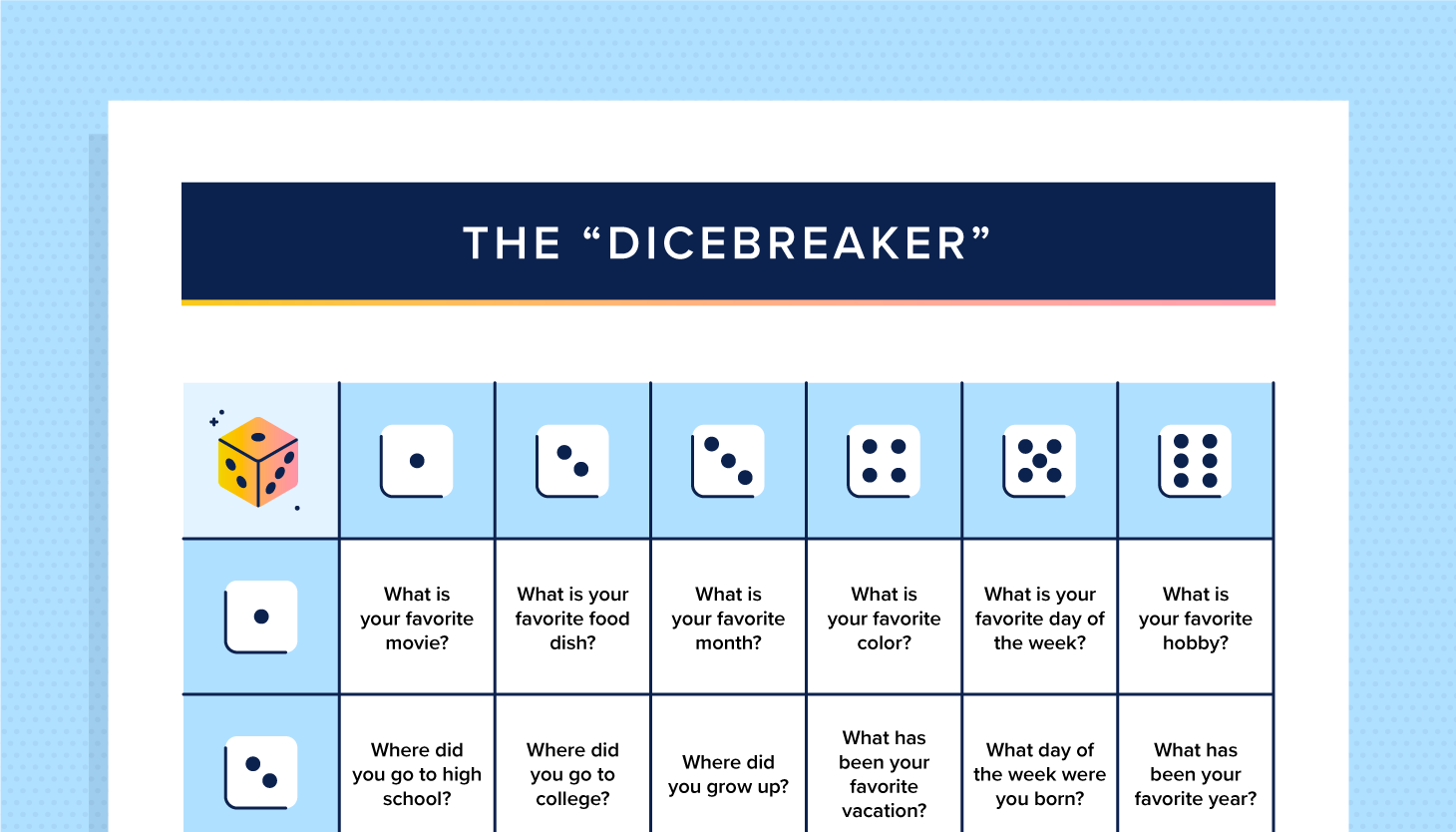61 Icebreaker Games for the Workplace in 2024

We’ve all been there: awkward beginnings to meetings that seem to suck the energy out of the room. To get coworkers excited and involved, you need a better starter than “Hello everyone” — you need an icebreaker game.
Icebreaker games are a fun way to encourage communication and team building while also setting a collaborative tone for the rest of the meeting. They can boost morale, improve employee relations, fuel creativity, reduce stress, and foster a positive workplace culture.
At ZoomShift, we know just how powerful a collaborative workplace can be — that’s why we’ve compiled a list of the 61 best icebreaker games for the workplace. From meeting starters to activities that will get people laughing, you are sure to find the perfect game for your next meeting.
Icebreakers for meetings
We’ll start our list with some icebreakers for meetings. With a focus on keeping things light, fun, and professional, these icebreakers are perfect for your next gathering.

1. Scavenger hunt
Start by dividing your attendees into small groups, and give them a list of tasks to do or things to find around the office. This can include specific objects or workers who fit certain criteria.
Include things like “find a coffee mug with the color purple on it” or “take a picture with a manager making a silly face” — and to make things fun, offer a prize for the winning team.
2. The candy game
Pick a multi-colored candy, such as Skittles or M&Ms, and place them into a large bowl. At the start of the meeting, pass the bowl around and instruct attendees to take as many as they want but refrain from eating them.
Each person then has to answer a question for each color they take. For example, everyone with a red piece of candy may have to answer, “What’s your favorite book?”
3. Paper airplane game
Distribute a stack of paper — multi-colored paper can make the activity a bit more fun — and ask everyone to write an interesting fact about themselves.
Then have everyone fold their paper into an airplane and throw it across the room. Each individual will pick up a random airplane, read the fact on it, and try to find the person who wrote it.
4. Year of the coin
If your group is comprised of younger professionals, this activity may be a bit more challenging, but the premise is simple: Bring a jar of coins to the group and have everyone randomly pick one.
Each individual will then share what they were doing in the year on their coin. For example, a person may share something like, “My coin says 2007; during that year I went to my first football game.”
5. One common thing
Create a list with everyone’s name on it and then give each person in the group a copy. Have everyone mingle with the goal of finding a commonality with each person in the room — and no repeating answers.
From cross-country skiing in high school to playing the flute in middle school band, employees will get to know their coworkers a little bit better with this activity.
6. Group trivia
Come up with a list of trivia questions and pair people up Have them work together in their teams to answer the questions, and give points to correct answers. At the end of trivia, tally up the points and give out a prize.
Any type of trivia works — it could be “guess that song” trivia, Disney trivia, trivia about a popular TV show, or anything else appropriate for your group.
7. Tic-tac-toe “bingo”
Ask everyone to fill out a tic-tac-toe board, but in each square have them include one of their interests. Everyone then walks around the room getting to know each other, and when two people share an interest, they both cross it off on their board. The first person to get three in a row wins.
It can be tough to accomplish this if everyone has interests that are too narrow, so encourage broad thinking. For example, rather than writing down “basketball,” suggest they write “sports.”
8. The four quadrants
Each person draws a 2×2 quadrant on a large piece of paper. Ask four questions to the group, and the attendees have to draw their answers in one of the quadrants. After all drawings have been completed, the group walks around and talks with each other about the questions and their drawings.
9. Team jigsaw
Split attendees into two groups and give them each a jigsaw puzzle.
The goal is to be the first team to finish their puzzle — but what they don’t know is that some of the pieces have been switched between the two puzzles, requiring both teams to work together. This is a fantastic activity to spark collaboration.
10. Wink banishment
Sit everyone in a circle and have each person draw a card. One person will draw the “banisher” card and the rest will draw “citizen” cards.
The banisher must banish a citizen by winking at them without getting caught by the other citizens. After someone has been banished, the remaining citizens will discuss who they think is the banisher.
The citizens vote out who they believe is the banisher. If they’re correct, the game is over; if they’re wrong, the game continues.
11. Trading cards
Have everyone in the group create their own trading card with a self-portrait, name, nickname, and fun facts.
People then mingle with each other, trading their cards and asking more questions about each person. At the end, everyone reads the card they’re left with out loud. The more trades that occur, the more people get to know each other.
12. Leave your shoes at the door
This activity starts with everybody leaving their shoes at the door. After people are seated, instruct them to grab a random pair of shoes and try to return them to their owner.
But there’s a catch: People can ask as many questions as they like, but they can’t ask anything about the shoes. The goal of this activity is for everyone to get to know each other and use that information to correctly guess and return each individual’s shoes.
13. Minefield
Find a conference room or meeting area that has (or can be made to have) a large space in the middle. Find soft objects such as pillows or cardboard boxes and place them in various spots around the floor.
Divide attendees into teams of two. One person is blindfolded, and the other needs to guide them across the room without hitting the objects on the floor. This is a great game for building trust and communication skills.
14. The blind square
Participants sit in a circle with a blindfold on.
Tie a long piece of rope together at both ends and get everyone to hold on to the rope. The aim is to turn the circle into a square without letting go of the rope. This is a fun and challenging activity that is sure to get people to communicate.
15. Group map
This activity comes in two stages.
First, go around the circle and have everyone describe where they come from (it can be where they were born, raised, or are currently living) without saying the place’s name.
Then pass out a piece of construction paper or other large writing surface. The entire group will ask each other further questions and work together to create a map that best encompasses where everyone is from.
16. All aboard the balloon train
Place balloons of varying colors around the room and split the group into large teams.
The teams stand in a line (like a train), aiming to fill their train with passengers (the balloons). Once you say “go,” each team tries to collect as many balloons as possible to “fill their train” — set a timer, and whichever team has the most passengers at the end wins.
As an added twist: Blindfold the person at the front of the train so their teammates need to instruct them.
17. Human billboards
Give everyone a large piece of paper and some colored markers. Using pictures, symbols, and words, each person will design a billboard to describe themselves.
Everyone will then attach their sign to their shirt using tape or string and walk around with their billboards, asking each other questions and discussing their designs.
18. Unique and shared
Split people into groups of four or five.
Each team has to find something unique about each person and something they all share in common as a group — these can be things about their personality, hobbies, fun facts, or anything else.
Once all groups have their answers, they’ll announce the results to the whole meeting.
19. Birth map
Before the meeting starts, place a large map at the front of the room. As attendees enter, have them place a thumbtack on the location where they were born, raised, or just call home.
Once everyone places their thumbtack, you could discuss the findings as a group or you could have each individual share where they’re from. At the end of the activity, attendees will have a better understanding of everyone’s background.
20. The marshmallow tower
Split everyone into teams and give them a marshmallow, one yard of string, one yard of tape, and 20 sticks of uncooked spaghetti. The goal is to build the tallest tower possible — and the marshmallow has to be on top.
While the rules are simple, this activity will get the creativity flowing!
Icebreakers for virtual meetings
Companies across the globe are gravitating toward remote work — and with that comes virtual meetings. Even over webcam, people management is crucial for managers, so here are some perfect icebreaker ideas for all the scattered teams out there.

21. Virtual scavenger hunt
Bring a list of household items to the meeting, and call them out one by one to your attendees. The first person to return to the screen with that item gets a point.
Include things like a book with a red cover, or a potted plant — and for a bit of friendly competition, offer a prize for the winner.
22. Two truths and a lie
Go around the meeting and have each person say three statements — two of them true and one a lie. The group then has to determine which statement is the lie. Pro tip: This game works best when the lie is believable.
Here’s an example: “I’m a vegetarian, I once backpacked across Italy for a month, and I adopted a puppy over the weekend.”
23. The friendly debate
Pick a lighthearted question and prompt people to spend a few minutes making a choice and coming up with reasons to back up their answer. This question could be something like, “Which is better: pizza or tacos?”
Next, split the group by their choices and allow the two teams to have a friendly debate. At the end, pick the winning side.
24. Eighteen and under
Ask each person to share an interesting story or accomplishment they experienced before turning 18. This is a great way to learn more about the group and discover hidden talents or skills.
25. The hot seat
One person is in the “hot seat,” and everyone in the meeting asks them one (work-appropriate) question about anything. You can have one person in the hot seat per meeting, or everyone can take a turn. The goal is to learn as much as possible about everyone in the room, so encourage creativity.
26. Around the world
Pick someone in the group to start by naming a country, city, town, river, mountain, or something similar.
The next person must then name a geographic feature beginning with the last letter of the word the person before them used. So if the first person said Peru, the second person might say Uganda, and the third person could say the Atlantic Ocean.
Words can’t be repeated, so as you take turns going around the meeting, it will get more difficult.
27. Build a story
The goal of this game is for team members to build a story one word at a time. The first person starts with the first word (such as “The”), the second person adds a second word (such as “man”), the third person adds another word (such as “walked”), and so on.
You can add rules to make this easier or more challenging, but overall, this is a fun activity to see where the group’s creativity can take a story.
28. Improv story
This activity is an upgraded version of the game above.
The first person says a sentence or two to start a story. The next person has to start with “suddenly,” and then build on that story with one or two sentences of their own, and so on. Once everyone in the group has spoken, you’ll have a wild and unpredictable story — bonus points if you record the activity to share for future team-building exercises!
29. Bucket list
Have everyone go around the group and share some bucket list items they would like to do in their lifetime. It can be anything from traveling to a certain part of the world to learning a new skill to achieving an important aspiration.
This game can also be motivational, as participants encourage each other to follow their dreams and achieve their goals.
30. Share a compliment
This activity can be done in a few different ways, but the goal is the same: Have attendees compliment each other.
You can perform this with the entire group, having people give compliments one by one, or you could split everyone into pairs or smaller groups. The goal is to have everyone both say and receive a compliment to start the meeting, which is a great way to build team morale and confidence.
31. Rose, thorn, bud
Rose, thorn, bud is a way for team members to share things they’re experiencing in their day-to-day activities.
Go around the group and have everyone share a rose (a recent “win” or positive aspect of their life or job), a thorn (a challenge they are currently facing), and a bud (an idea or way to improve operations for the future). This activity will give you a great sense of where everyone’s head is and how they are currently performing.
32. Two sides of a coin
Ask each person in the group to share a negative experience. The group will listen and help identify a positive aspect of the situation.
An interaction may look like this:
Negative: “Yesterday I got a flat tire and no one could come to help, so I had to do it on my own.”
Positive: “The positive experience is that you learned how to change a tire so you will be prepared if that situation happens again.”
Quick icebreakers
Every meeting should have an icebreaker, but sometimes time management is an issue. In that case, choose one of our quick icebreakers below to boost morale and collaboration in a snap.

33. Bowl of questions
On small strips of paper, write out a handful of playful or thought-provoking questions and place them into a bowl. Pass the bowl around the group, and have each individual read and answer the question they pulled.
34. Speed networking
Pair everyone up and set a two-minute timer. Give everyone a conversation starter and have them talk to each other until the timer is up. Once the timer sounds, have everyone switch partners and give them a different question. Continue until everyone has met.
35. Would you rather?
Ask a question to the group and have everyone hold up one finger if they choose option one or two fingers if they choose option two.
For example, you might say, “Would you rather: 1. Be able to talk to animals, or 2. Wake up always feeling rested?”
36. Have you ever?
Create a work-appropriate list of questions that can be answered with a yes or no. Ask people to stand up or raise their hand if their answer is yes, and stay seated if their answer is no.
You may ask something along the lines of, “Have you ever re-gifted something?” or “Have you ever flown in a helicopter?”
37. Favorite things
Have each person answer a question about their favorite things. It can be TV shows, books, movies, food, or anything else to get to know the group on a more personal level.
If people have trouble coming up with their favorites, you can shift the question to “one thing you’ve enjoyed recently.”
38. Jenga questions
Take a normal Jenga set and write interesting and thought-provoking questions on each block. When each person pulls a block, they read the question and answer aloud to the group before continuing their turn.
39. The “dicebreaker”
Split the group into pairs, and pass out a set of dice and a sheet of instructions. These instructions will have different questions for each combination of possible dice rolls, such as, “What is your favorite movie?” or “What is your favorite food?”
Have the pairs spend a few minutes rolling dice and asking the corresponding questions on the instructions. You could also have the pairs rotate to ensure everyone gets to know each other.
For an easy template, download our link below:

40. The movie pitch
Break the group into two or more teams. Each team must decide on a movie they would like to recreate.
The teams then make a pitch to the group to explain why their movie idea deserves funding. After all the pitches have been made, the rest of the group votes to see which pitch deserves to be turned into a Hollywood blockbuster.
41. Crowd participation
Split the group into as many teams as you’d like. Each team has to come up with their own icebreaker game and then pitch the idea to the group. After hearing all of the pitches, the entire group will vote on the best icebreaker to play.
42. Desert island
The team has been trapped on a desert island!
Each team member can bring one book, one piece of music, and one luxury item — what do they choose? Take turns for each team member to say what they would bring with them and why.
43. Picture this
Each person draws an image that represents them as a person. Pair up attendees and have them each explain the meaning of their picture to each other. Once everyone has thoroughly discussed their works of art, have each pairing present to the entire group.
44. Find your pair
Write different words on a handful of Post-it notes, making sure each word is part of a pair. (For example, if you write “salt” on one of the Post-its, make sure to write “pepper” on another.)
Stick a Post-it on each person’s back. Their goal is to walk around the room and ask the group questions until everyone has found their pair.
45. Purpose mingle
Have people walk around and say what they will contribute to this event, meeting, or session. It’s a chance to get to know people and understand what they bring to the table.
46. Talent show
In a talent show activity, go around the group and have everyone share (or perform) one of their talents. These can be as simple as wiggling their ears or something more complex like playing guitar or being a scratch golfer.
Alert attendees before the meeting so they have plenty of time to come up with the talent they’d like to share.
Humorous icebreakers
Day-to-day tasks like client communication, work scheduling, and other seemingly mundane tasks can cause employee burnout. Boost morale with some funny icebreakers at your next meeting. Below are some perfect ways to get the laughter flowing.

47. Heads up
This popular game — available for iOS and Android — is a variation of Taboo. One person goes to the front of the room and puts a smartphone up to their forehead so the group can see the screen but they can’t. The screen shows a person, place, or thing, and the group has to give clues until the person guesses what’s on the screen.
48. Explain that ‘Gram
Have each individual scroll through their Instagram, other social media, or camera roll on their phone, and share an image with everyone. Have them explain why they picked it and any backstory that goes along with it.
49. Straight face game
Create a list of work-appropriate jokes and pair everyone into groups of two. The goal for each person is to get their partner to laugh while the partner tries their hardest to keep a straight face.
The person who can get their partner to “break,” the most wins.
50. Line ‘em up
Ask the group to line up in a certain order. This could be based on height, hair color, years with the company, or any other appropriate criteria.
The catch is that attendees have to line up correctly without speaking to each other. This activity can be a fun way to spark nonverbal communication and collaboration.
51. No smiling please
When everyone arrives, announce to the group that nobody can smile for the first five to 10 minutes of the meeting.
This goes against common convention for a meeting and gets people to do something a little different. Attendees might be surprised at how difficult it is not to smile — which will be sure to create some fun situations.
52. Share an embarrassing photo
This activity is fairly simple: Ask every attendee to share an embarrassing photo of themselves. Doing so will reveal some funny stories and allow people to share a side of themselves that may not usually come out at work.
53. Name that person
Split your team into two groups.
Each person writes five interesting facts about themselves and puts them into a pile with the rest of their group. The groups then swap cards and have to guess which fact belongs to which person.
54. One-liners
Start by splitting the group up into pairs.
Each pair has to come up with a quote from a book, movie, or song. The pairs read their quotes one by one, while the other teams write down where the quote came from.
Each correctly identified quote is worth one point. Teams that come up with a unique quote that nobody else used get a bonus point.
55. Secret identity
Start by splitting the group into pairs.
Each participant will write the name of a well-known person on a Post-it note, and then stick it on their partner (making sure the partner doesn’t see who it is). Players then take turns asking yes or no questions to discover the secret identity. The pairing that figures out both identities first wins!
56. The wind game
This game is a fun variation of musical chairs.
Start by sitting everyone in a circle, and have one person standing up in the middle. That person will say a variation of “the wind blows….” followed by a description that fits many people in the group. For example, they could say, “The wind blows everyone wearing the color green.”
Those who fit the description — as well as the person in the middle — will then scramble to find an open chair to sit in. The person who’s left standing has to be in the middle for the next round.
57. Toilet paper roll
Pass a roll of toilet paper around and have everyone take off as many squares as they would normally use in the bathroom. Once the roll has made it to everyone, each individual has to share one fun fact about themselves for every square of toilet paper they took.
This game allows attendees to be themselves, but it would be best to do this in a group that already knows each other.
58. Name that tune
One by one, have everyone in the meeting play a tune of one of their favorite songs. But here’s the catch: They can’t use the actual song itself. Instead, instruct attendees to whistle, tap on the floor, snap their fingers, or perform any other noise-making activity to “play” the song.
The first person in the audience to guess the song correctly gets a point, and the individual with the most points at the end gets a prize.
59. The handshake
Split up your group into pairs of two and instruct the teams to create a unique handshake. It could be professional or silly — as long as they use their creativity.
Then, have every pair stand up and present their creation. Have everyone vote on whose handshake was the best, and give a small prize to the winner.
60. Red light, green light
Everyone likely knows this game from one playground or another — but if you don’t, the goal is for a player to get from one side of the room to the other without moving on the “red light.”
Have your attendees line up on one wall and station yourself on the other. When you say “green light” everyone is free to move, but as soon as you say “red light” everyone has to stand still — and if they move at all, they’re out. The first person to reach the other wall wins!
61. Backward name game
At the start of the meeting, give everyone a slip of paper and have them write their name backward.
Collect the papers in a bowl, and one by one, have individuals grab a name from the bowl and try to figure out whose name it is in front of the group. You can encourage engagement from the rest of the group, which leads to a playful team-building exercise.
Collaborate more efficiently with ZoomShift
It’s important to engage employees at the start of every meeting, and one of the best ways to do so is with an icebreaker game. When used properly, these activities can increase participation, collaboration, and workplace morale.
If you want to ensure your workplace stays positive beyond the icebreaker, check out our free work schedule maker and time tracker to revolutionize your productivity and work culture.
JD enjoys teaching people how to use ZoomShift to save time spent on scheduling. He’s curious, likes learning new things everyday and playing the guitar (although it’s a work in progress).




